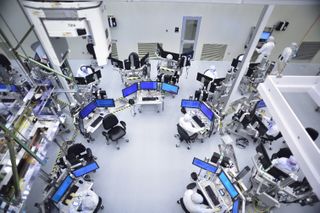Intel Confirms Oregon Expansion for 7nm Chip Production (Update)

Update - 2/5/19, 7:30 a.m. PT: The Oregonian reported today that Intel has confirmed plans to build "a massive new semiconductor factory in Hillsboro, which will surely run in the billions of dollars and rank among the largest capital projects in Oregon history." Many details about the project are still unknown, however, including when Intel plans to break ground on the new factory. We expect to hear more about the company's progress throughout 2019.
Original article - 1/22/19, 5 a.m. PT:
Intel doesn’t plan to let its continued 14nm shortage or inability to ship 10nm processors stop it from planning the factories where it will make the 7nm chips expected to debut in a few years. The Oregonian reported that the company plans to expand its Oregon factory, D1X, to prep for the 7nm shift.
The report cited anonymous sources in Oregon’s construction industry as saying that “Intel has spoken openly about its D1X plans and expect the project to last at least 18 months, followed by several months of equipment installation,” and that “sources inside Intel’s manufacturing operation also have been told to prepare for a major Oregon project this year.”
Intel senior vice president and general manager of Manufacturing and Operations Dr. Ann Kelleher announced in December 2018 that the company was “in the early planning phase for manufacturing site expansions in Oregon, Ireland, and Israel.” Details were scarce, but Kelleher said Intel had “multi-year construction activities expected to begin in 2019.”
Kelleher also said that Intel planned to start discussing its plans with local officials and going through the permitting process “in the weeks and months ahead.” All of that lines up with The Oregonian’s report—the Oregon expansion, the estimated timeframe, and the fact that the project hasn’t even reached the point where Intel’s had to involve city officials.
The alignment of those details lends more credence to the rest of The Oregonian’s report, which said that Intel plans to expand the existing 2.2 million-square-foot D1X factory with a third “phase” that will add another 1.1 million square feet. The new factory is expected to be where Intel plans to produce 7nm chips via extreme ultraviolet lithography (EUV).
Stay On the Cutting Edge: Get the Tom's Hardware Newsletter
Join the experts who read Tom's Hardware for the inside track on enthusiast PC tech news — and have for over 25 years. We'll send breaking news and in-depth reviews of CPUs, GPUs, AI, maker hardware and more straight to your inbox.
This expansion will do little to help Intel in the short term—it’s not like the company plans to have the construction workers make 14nm chips on their breaks. This is to help make sure it won’t run into the same problems with its 7nm chips; Kelleher said the construction would let the company “reduce our time to increased supply by up to roughly 60 percent.”
We could learn more about Intel’s reported Oregon expansion on January 23, when the company is also expected to reveal its pick for chief executive. (You know, more than six months after Brian Krzanich left the company, and two months after he found a new gig.) Hopefully whoever they pick is ready to spend a few billion dollars in Oregon.

Nathaniel Mott is a freelance news and features writer for Tom's Hardware US, covering breaking news, security, and the silliest aspects of the tech industry.
-
ingtar33 so it looks like 10nm won't happen. How does intel get a pass for a completely paper launch? Furthermore how is it supposed to launch 7nm when it doesn't really have any fabs for it?Reply -
hannibal Intel still is big player with enormous amounth of money. They can develop two three production technology at the same time. Paraller architecture development Also... all that just reduces the profit so They don`t do it unless They have to now They have to do it. Intel will come back that is sure, but it sure is nice to have amd in small lead at this moment. It forses Intel not to sit on their thumbs and do minor improvements. Now They really have to work for their money and that is good to customers!Reply
Hopefully TSMC and Samsung can keep up with Intell this time so that it has to be on its toes all the time! -
pug_s Reply21702042 said:Fabless in 10 years, no more advantage for Intel having fabs.
I don't know about that. If Intel is smart, they would split up its Fab and CPU manufacturer companies like what AMD did.
-
shrapnel_indie Reply21702249 said:so it looks like 10nm won't happen. How does intel get a pass for a completely paper launch? Furthermore how is it supposed to launch 7nm when it doesn't really have any fabs for it?
Well, they got a pass for what was nearly a paper launch of Broadwell. They scraped by with just a minimal launch in small quantities. and almost immediately launched its successor with new motherboard requirement.
They're managing some 10nm SKUs... but so far it's pretty limited to the mobile market (IIRC) -
Et2Brute So, by the time Intel has 7nm capability the semiconductor industry will be producing the next node. I think Intel is about to get an important lesson on how hard it is to play catch up.Reply -
hannibal Intels 10nm is smaller than others 7nm.. so intels 7 is smaller than others 5nm... You can not compare the marketing numbers... They are just that marketing, without any real world relation. But yep. at least at this moment Intel is in situation to catch up, or at least it will be in the summer.Reply -
jimmysmitty Reply21702249 said:so it looks like 10nm won't happen. How does intel get a pass for a completely paper launch? Furthermore how is it supposed to launch 7nm when it doesn't really have any fabs for it?
10nm is launching later this year.
They started a bit ago retooling FAB42 in Chandler for 7nm, it was originally tooled for 10nm but never got opened. The FAB is built already just needs the equipment. That will probably be the primary site for it with DX1 now being a second site for 7nm production.
Most Popular




